Compact Quad-Element High-Isolation Wideband MIMO Antenna for mm-Wave Applications
Abstract
:1. Introduction
2. Antenna Design and Analysis
2.1. Antenna Element
2.2. MIMO Antenna System
3. Results and Discussion
3.1. S-Parameters
3.2. 2D Radiation Patterns (Far Field)
3.3. MIMO Performance Metrics
4. Conclusions
Author Contributions
Funding
Data Availability Statement
Conflicts of Interest
References
- Hussain, N.; Jeong, M.; Abbas, A.; Kim, T.; Kim, N. A metasurface-based low-profile wideband circularly polarized patch antenna for 5G millimeter-wave systems. IEEE Access 2020, 8, 22127–22135. [Google Scholar] [CrossRef]
- Imran, D.; Farooqi, M.M.; Khattak, M.I.; Ullah, Z.; Khan, M.I.; Khattak, M.A.; Dar, H. Millimeter wave microstrip patch antenna for 5G mobile communication. In Proceedings of the 2018 International Conference on Engineering and Emerging Technologies (ICEET), Lahore, Pakistan, 22–23 February 2018; pp. 1–6. [Google Scholar]
- Vo, N.S.; Duong, T.Q.; Guizani, M.; Kortun, A. 5G optimized caching and downlink resource sharing for smart cities. IEEE Access 2018, 6, 31457–31468. [Google Scholar] [CrossRef]
- Khan, J.; Sehrai, D.A.; Khan, M.A.; Khan, H.A.; Ahmad, S.; Ahmad, S.; Ali, A.; Arif, A.; Memon, A.A.; Khan, S. Design and performance comparison of rotated Y-shaped antenna using different metamaterial surfaces for 5G mobile devices. Comput. Mater. Contin. 2019, 2, 409–420. [Google Scholar] [CrossRef]
- Nosrati, M.; Tavassolian, N. A single feed dual-band, linearly/circularly polarized cross-slot millimeter-wave antenna for future 5G networks. In Proceedings of the IEEE International Symposium on Antennas and Propagation and USNC/URSI National Radio Science Meeting, San Diego, CA, USA, 9–14 July 2017; pp. 2467–2468. [Google Scholar]
- Zhang, P.; Yang, B.; Yi, C.; Wang, H.; You, X. Measurement based 5G millimeter-wave propagation characterization in vegetated suburban macrocell environments. IEEE Trans. Antennas Propag. 2020, 68, 5556–5567. [Google Scholar] [CrossRef]
- Gan, Z.; Tu, Z.; Xie, Z. Millimeter wave high-isolated MIMO antenna with two opposite radiation directions. In Proceedings of the IEEE Asia-Pacific Microwave Conference (APMC), Kyoto, Japan, 6–9 November 2018; pp. 1010–1012. [Google Scholar]
- Yang, B.; Yu, Z.; Dong, Y.; Zhou, J.; Hong, W. Compact tapered slot antenna array for 5G millimeter-wave massive MIMO systems. IEEE Trans. Antennas Propag. 2017, 65, 6721–6727. [Google Scholar] [CrossRef]
- Seker, C.; Ozturk, T.; Guneser, M.T. A single band antenna design for future millimeter wave wireless communication at 38 GHz. Eur. J. Eng. Form. Sci. 2018, 2, 35–39. [Google Scholar]
- Ashraf, N.; Haraz, O.M.; Ali, M.M.; Ashraf, M.A.; Alshebili, S.A. Optimized broadband and dual-band printed slot antennas for future millimeter wave mobile communication. AEU Int. J. Electron. Commun. 2016, 70, 257–264. [Google Scholar] [CrossRef]
- Sharaf, M.; Zaki, A.; Hamad, R.; Omar, M. A novel dual-band (38/60 GHz) patch antenna for 5G mobile handsets. Sensors 2020, 20, 2540. [Google Scholar] [CrossRef] [PubMed]
- Yang, Y.; Sun, B.; Guo, J. A low-cost, single-layer, dual circularly polarized antenna for millimeter-wave applications. IEEE Antennas Wirel. Propag. Lett. 2019, 18, 651–654. [Google Scholar] [CrossRef]
- Yang, Y.; Sun, B.; Guo, J. A single-layer wideband circularly polarized antenna for millimeter-wave applications. IEEE Antennas Wirel. Propag. Lett. 2019, 68, 4925–4929. [Google Scholar] [CrossRef]
- Ojaroudiparchin, N.; Shen, M.; Zhang, S.; Pedersen, G. A switchable 3-D-coverage-phased array antenna package for 5G mobile terminals. IEEE Antennas Wirel. Propag. Lett. 2016, 15, 1747–1750. [Google Scholar] [CrossRef] [Green Version]
- Costa, I.F.; Cerqueira, A.; Spadoti, D.H.; Silva, L.G.; Ribeiro, J.A.; Barbin, S.E. Optically controlled reconfigurable antenna array for mm-wave applications. IEEE Antennas Wirel. Propag. Lett. 2017, 16, 2142–2145. [Google Scholar] [CrossRef] [Green Version]
- Marzouk, H.M.; Ahmed, M.I.; Shaalan, A.A. A novel dual-band 28/38 GHz AFSL MIMO antenna for 5G smartphone applications. J. Phys. Conf. Ser. 2020, 1447, 012025. [Google Scholar] [CrossRef]
- Iqbal, A.; Basir, A.; Smida, A.; Mallat, N.; Elfergani, I.; Rodriguez, J.; Kim, S. Electromagnetic bandgap backed millimeter-wave MIMO antenna for wearable applications. IEEE Access 2019, 7, 111135–111144. [Google Scholar] [CrossRef]
- Sunthari, P.M.; Veeramani, R. Multiband microstrip patch antenna for 5G wireless applications using MIMO techniques. In Proceedings of the IEEE First International Conference on Recent Advances in Aerospace Engineering (ICRAAE), Coimbatore, India, 3–4 March 2017; pp. 1–5. [Google Scholar]
- Tu, D.T.T.; Thang, N.G.; Ngoc, N.T.; Phuong, N.T.B.; Yem, V.V. 28/38 GHz dual-band MIMO antenna with low mutual coupling using novel round patch EBG cell for 5G applications. In Proceedings of the IEEE International Conference on Advanced Technologies for Communications (ATC), Quy Nhon, Vietnam, 18–20 October 2017; pp. 64–69. [Google Scholar]
- Hasan, M.; Bashir, S.; Chu, S. Dual band omnidirectional millimeter wave antenna for 5G communications. J. Electromagn. Waves Appl. 2019, 33, 1581–1590. [Google Scholar] [CrossRef]
- Hussain, N.; Jeong, M.; Park, J.; Kim, N. A broadband circularly polarized fabry-perot resonant antenna using a single-layered PRS for 5G MIMO applications. IEEE Access 2019, 7, 42897–42907. [Google Scholar] [CrossRef]
- Khan, J.; Sehrai, D.A.; Ali, U. Design of dual band 5G antenna array with SAR analysis for future mobile handsets. J. Electr. Eng. Technol. 2019, 14, 809–816. [Google Scholar] [CrossRef]
- Rangan, S.; Rappaport, T.S.; Erkip, E. Millimeter-wave cellular wireless networks: Potentials and challenges. Proc. IEEE 2014, 102, 366–385. [Google Scholar] [CrossRef] [Green Version]
- Balanis, C. Antenna Theory: Analysis and Design; John Wiley and Sons: Hoboken, NJ, USA, 2016. [Google Scholar]
- Kiani, S.H.; Altaf, A.; Abdullah, M.; Muhammad, F.; Shoaib, N.; Anjum, M.R.; Damaševičius, R.; Blažauskas, T. Eight element side edged framed MIMO antenna array for future 5G smart phones. Micromachines 2020, 11, 956. [Google Scholar] [CrossRef] [PubMed]
- Lin, I.K.; Jamaluddin, M.H.; Awang, A.; Selvaraju, R.; Dahri, M.H.; Yen, L.C.; Rahim, H.A. A triple band hybrid MIMO rectangular dielectric resonator antenna for LTE applications. IEEE Access 2019, 7, 122900–122913. [Google Scholar]
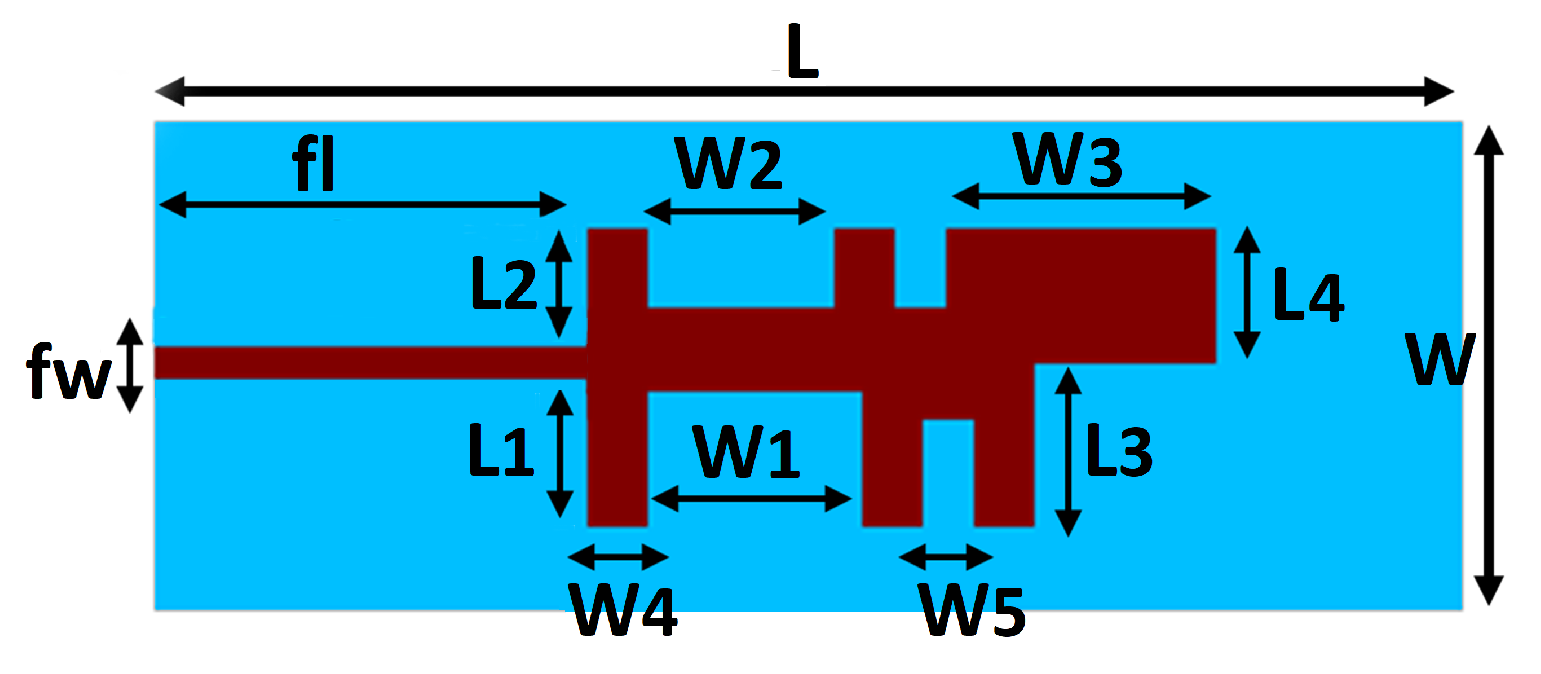

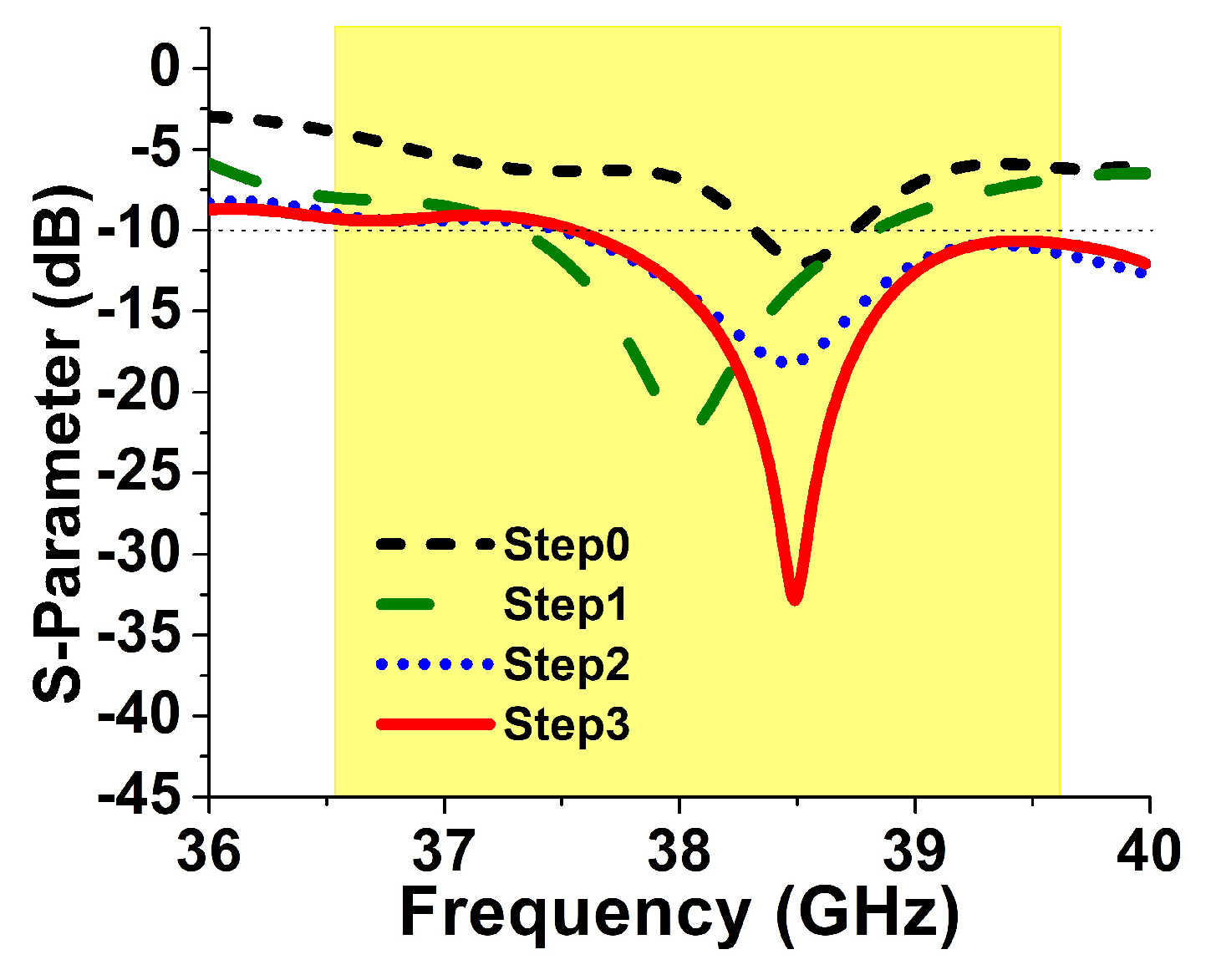
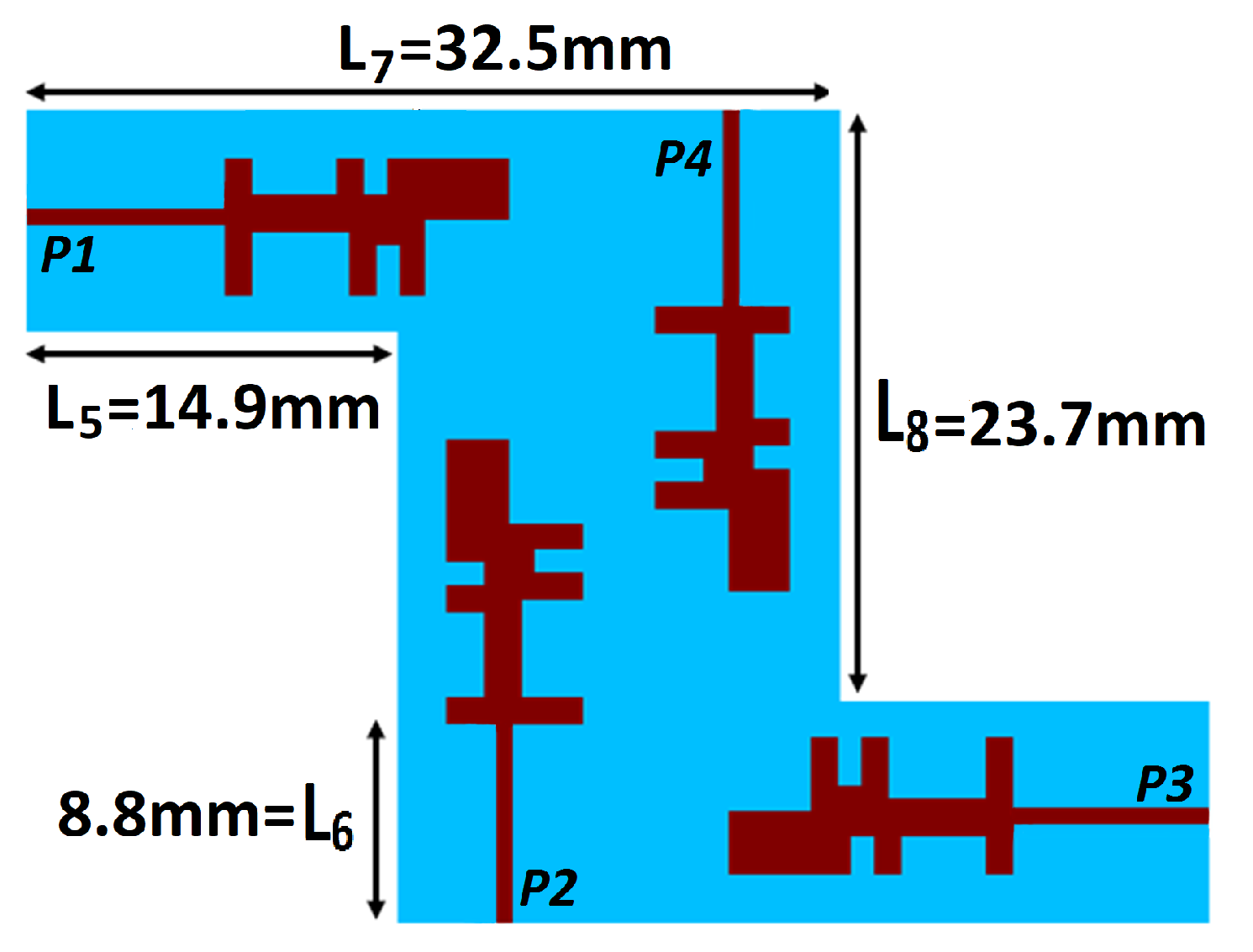
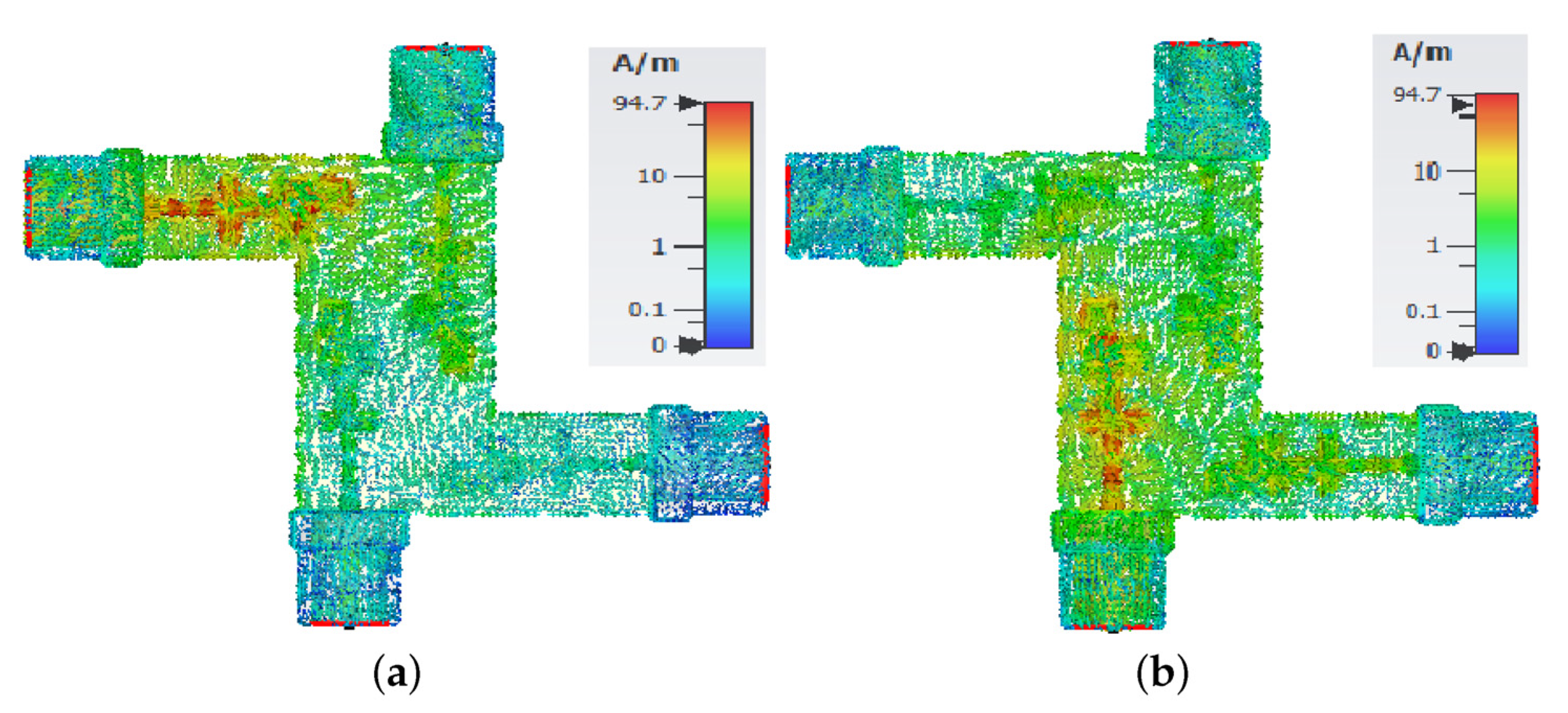
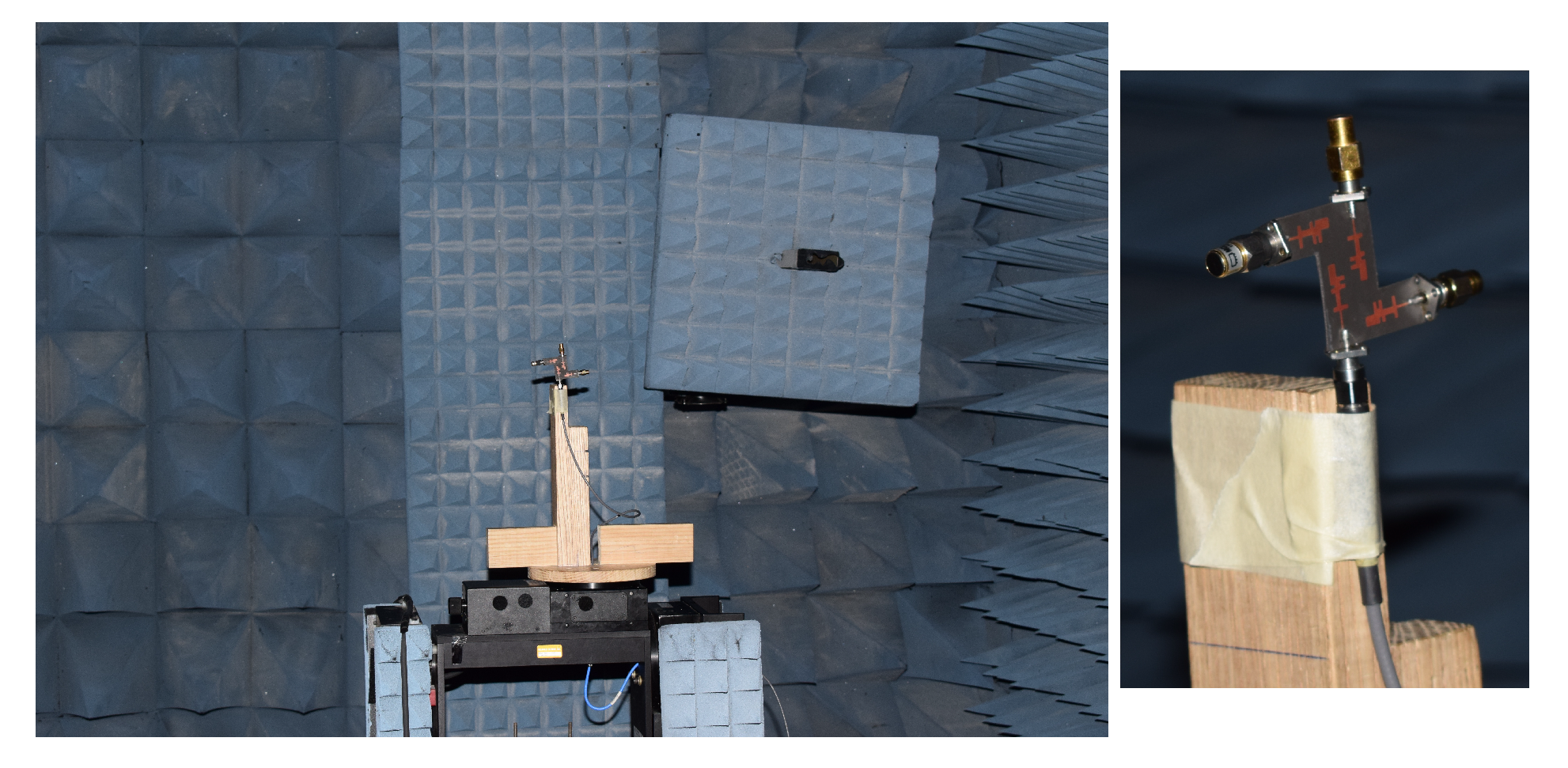
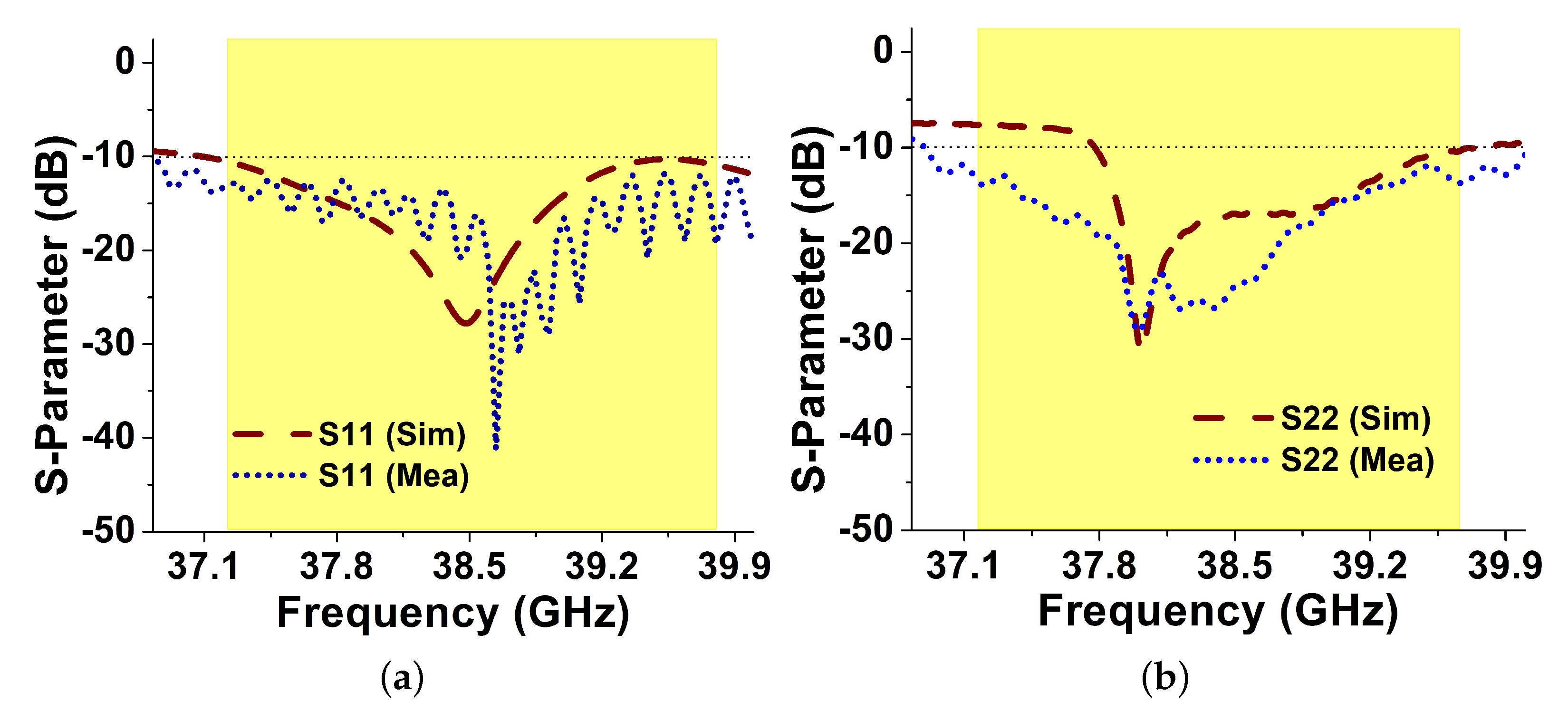
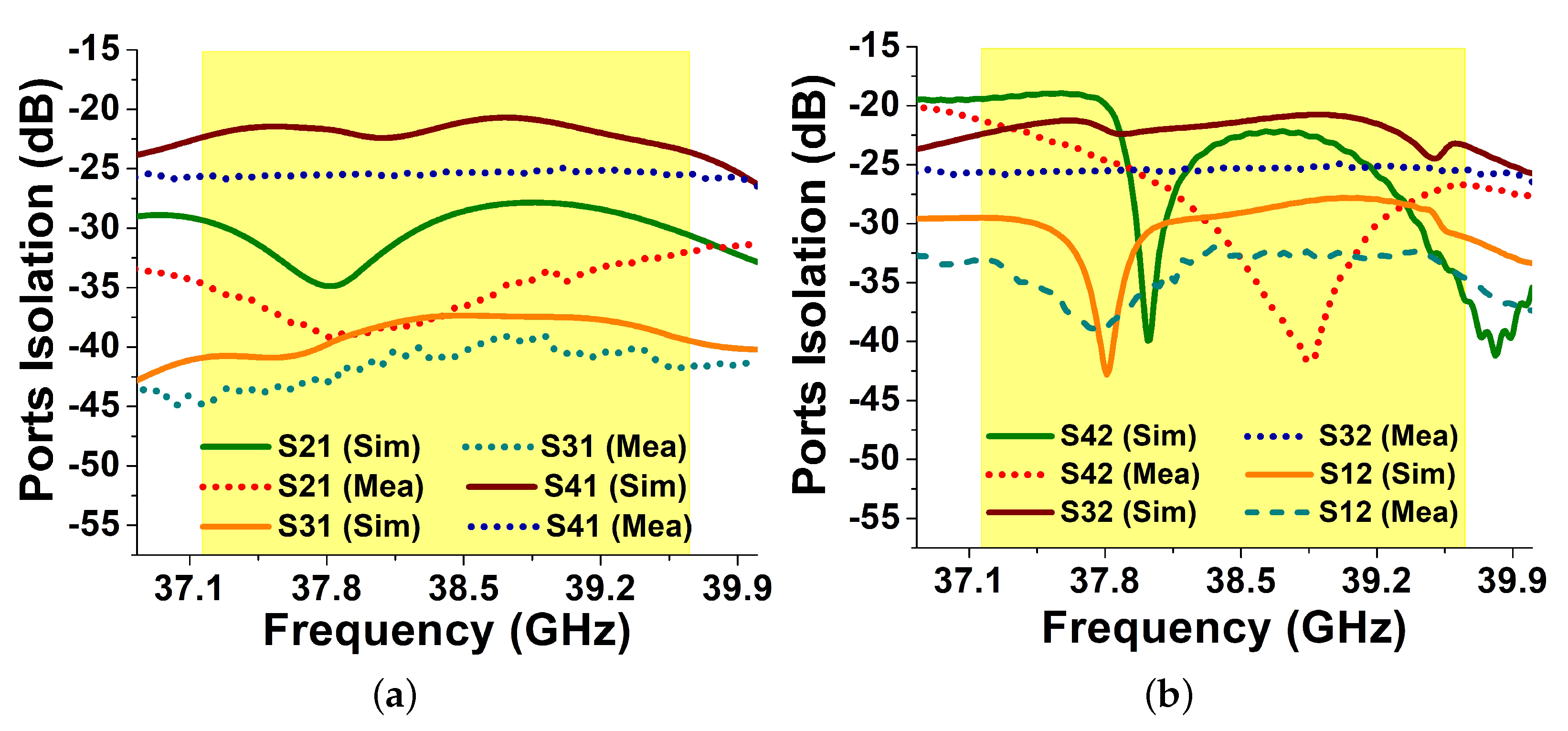
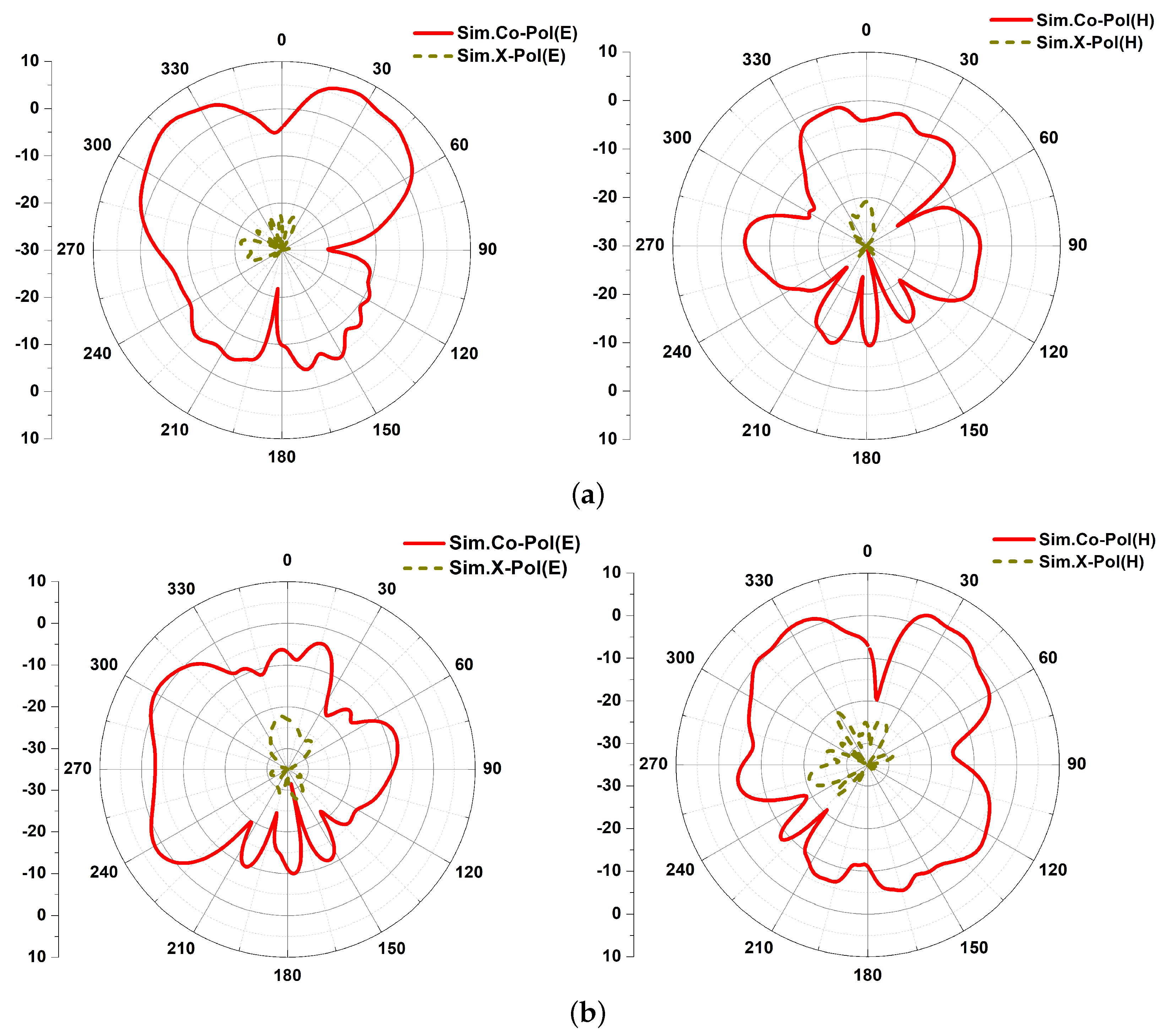
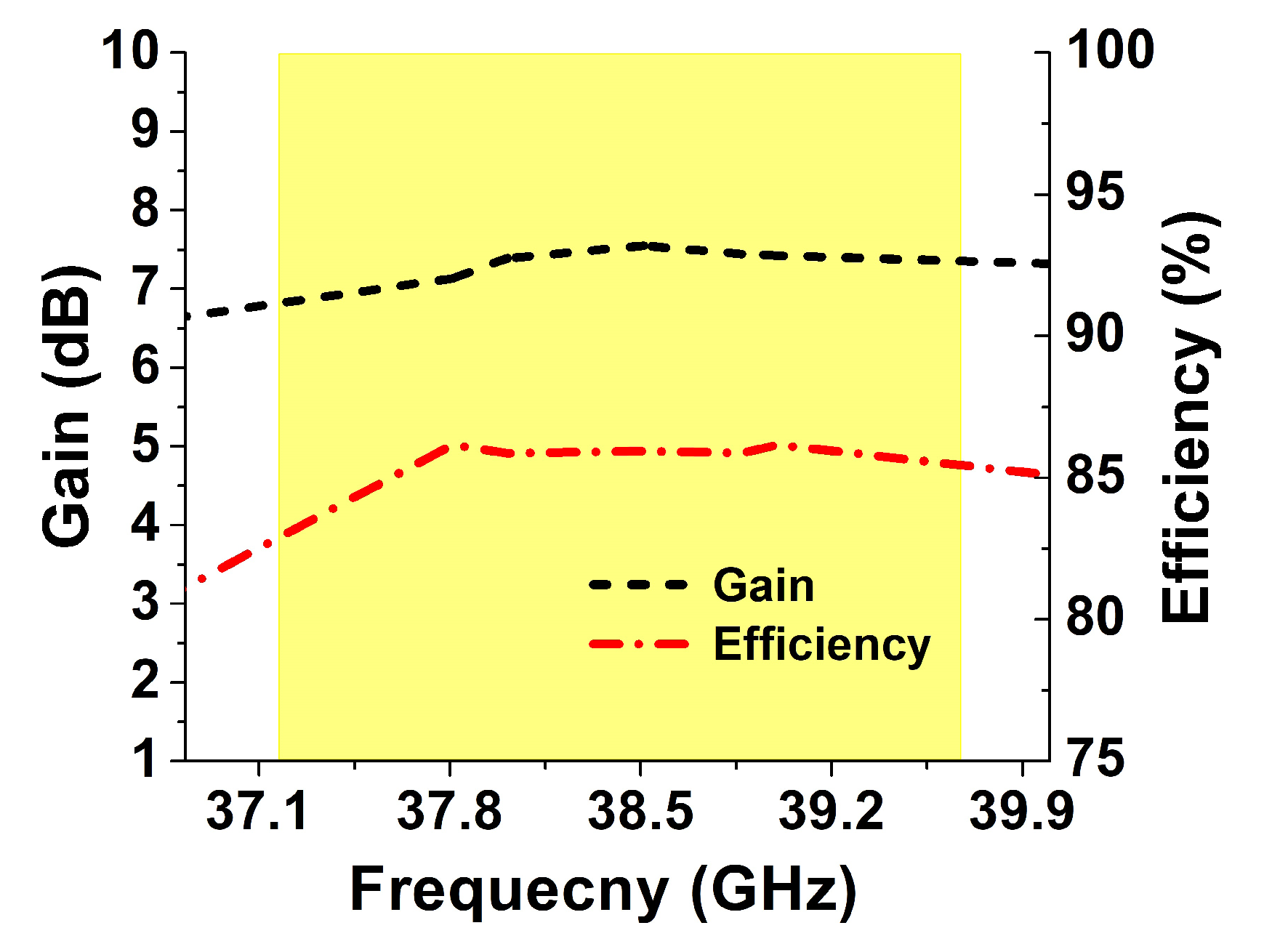

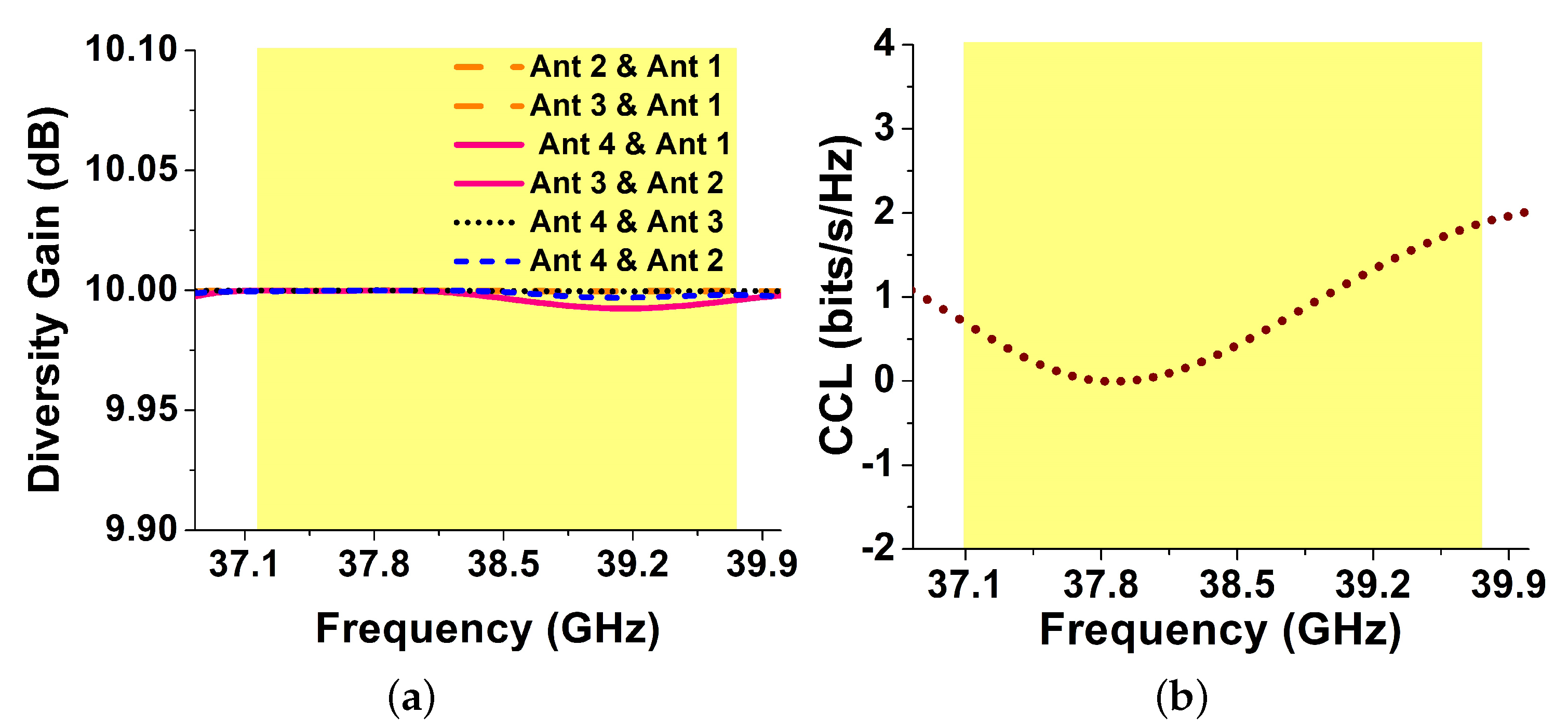
| Parameter | Value (mm) | Parameter | Value (mm) |
|---|---|---|---|
| W | 8.8 | L4 | 2.4 |
| L | 23.7 | W1 | 4.0 |
| fw | 0.51 | W2 | 3.5 |
| fl | 7.92 | W3 | 4.85 |
| L1 | 2.6 | W4 | 1.0 |
| L2 | 2.3 | W5 | 1.0 |
| L3 | 3.0 | – | – |
| Freq. (GHz) | Value (dB) |
|---|---|
| 37.8 | 6.5 |
| 38.5 | 6.25 |
| 39.2 | 5.5 |
| Ref. | Ports | Operat. BW. | Gain (dB) | Iso. (dB) | Ant. Size (mm) |
|---|---|---|---|---|---|
| [9] | 1 | 37.1–38.12 | 1.26 | – | 8 × 5.9 × 1.6 (1.0 × 0.73 × 0.2 ) |
| [11] | 1 | 37.16–38.36 | 6.5 | – | 15 × 25 × 0.25 (2.0 × 3.1 × 0.031 ) |
| [16] | 3 | 37.3–38.6 | 4.60 | −28 | 55 × 110 × 1.6 (7.0 × 13.5 × 0.2 ) |
| [18] | 4 | 36.68–37.32 | 5.2 | – | 26.6 × 3.25 × 1.6 (3.2 × 0.4 × 0.2 ) |
| [19] | 4 | 38.02–38.37 | 5.72 * | −34.8 | 19.25 × 26 × 0.79 (2.5 × 3.3 × 1.0 ) |
| [20] | 2 | 36.95–39.05 | 1.83 | −21 | 26 × 14 × 0.38 (3.2 × 1.8 × 0.047 ) |
| Prop. | 4 | 36.83–40.0 | 6.5 | −45 | 47.4 × 32.5 × 0.51 (5.2 × 4.05 × 0.063 ) |
Publisher’s Note: MDPI stays neutral with regard to jurisdictional claims in published maps and institutional affiliations. |
© 2021 by the authors. Licensee MDPI, Basel, Switzerland. This article is an open access article distributed under the terms and conditions of the Creative Commons Attribution (CC BY) license (https://creativecommons.org/licenses/by/4.0/).
Share and Cite
Sehrai, D.A.; Asif, M.; Shoaib, N.; Ibrar, M.; Jan, S.; Alibakhshikenari, M.; Lalbakhsh, A.; Limiti, E. Compact Quad-Element High-Isolation Wideband MIMO Antenna for mm-Wave Applications. Electronics 2021, 10, 1300. https://doi.org/10.3390/electronics10111300
Sehrai DA, Asif M, Shoaib N, Ibrar M, Jan S, Alibakhshikenari M, Lalbakhsh A, Limiti E. Compact Quad-Element High-Isolation Wideband MIMO Antenna for mm-Wave Applications. Electronics. 2021; 10(11):1300. https://doi.org/10.3390/electronics10111300
Chicago/Turabian StyleSehrai, Daniyal Ali, Muhammad Asif, Nosherwan Shoaib, Muhammad Ibrar, Saeedullah Jan, Mohammad Alibakhshikenari, Ali Lalbakhsh, and Ernesto Limiti. 2021. "Compact Quad-Element High-Isolation Wideband MIMO Antenna for mm-Wave Applications" Electronics 10, no. 11: 1300. https://doi.org/10.3390/electronics10111300








